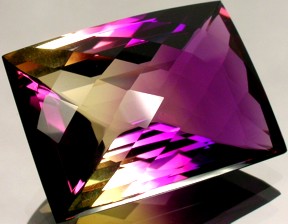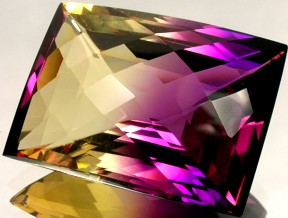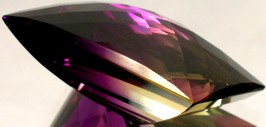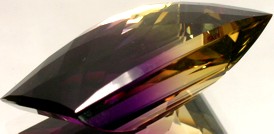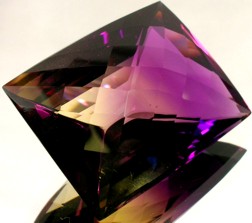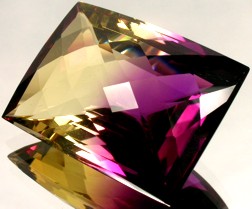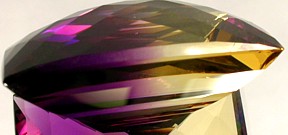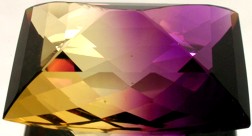| 67ct Russian Handcut Bolivian Amethyst-Citrine Ametrine 31mm*23mm - $399.99 #58988
For Customers outside of USA 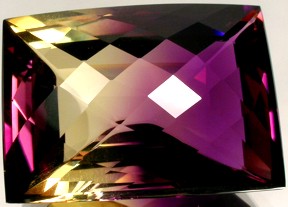
HUGE Sixty-Seven Carat Russian Handcrafted Checkerboard Faceted Baguette Cut, Genuine Natural Ametrine Semi-Precious Gemstone. GEMSTONE ORIGIN: Bolivia's Anahi Mine. 19th Century. SIZE: Length: 31mm. Width: 23mm. Depth: 14mm. All measurements approximate. WEIGHT: 66.88 carats. NOTES: Upon request we can set your gemstones as a ring, pendant, or as earrings.
DETAIL: You can think of Ametrine as a gemstone quality quartz crystal which when growing up could not decide whether it wanted to be an Amethyst or a Citrine, and so developed a "split personality". This is a very large, very clean, handcrafted checkerboard faceted "baguette" cut ametrine semi-precious gemstone from the Anahi Mine in Bolivia. Exported to Russia for use in indigenous jewelry, the gemstone was hand crafted and faceted by a Russian artisan, part of a centuries-long heritage renown for the production of the elaborate gemstones and jewelry of the Czars of Medieval, Renaissance, and Victorian Russia. Ametrine is actually very rare in nature, having both the manganese traces which produce amethyst's purple, as well as the iron traces which produce citrine's yellow. The crystals must then be exposed to a variable source of heat, such as might be the case when a crystal partly encased in rock is exposed on one surface to sun shine. Slowly a portion of the gemstone will change color from amethyst's purple to citrine's yellow. This occurs rather rarely in nature.
It seems that the ancient Mediterranean world knew of ametrine. The ancient source for ametrine was likely India via camel caravan through Persia. With the ancient source of ametrine lost and forgotten, ametrine was (re)introduced to Renaissance Europe as "trystine" from a Bolivian source in the seventeenth century. It was considered a very rare gemstone and was extremely expensive in Victorian Europe. Natural ametrine remains rather rare. Today most modern ametrine is either synthetic or induced by irradiating or heat-treating amethyst. This particular specimen is entirely natural in origin, and is as you can see a very nicely colored semi-precious gemstone, with nice delineation between the yellow and purple. And as you can also see from the photo enlargements here, it is to the eye completely transparent and free from inclusions, and possesses exceptional sparkle and luster. It is very clean, water clear, and very bright.
The gemstone was hand cut into a sparkling, brilliant, checkerboard faceted "baguette" with lots of flash and depth. Under magnification the gemstone shows the unmistakable characteristics of having been hand crafted. The coarseness of the handcrafted finish is considered appealing to most gemstone collectors, and is not considered a detriment, or to detract from the value of a gemstone. Of course these characteristics are not only expected of hand-finished gemstones, most serious collectors consider such gemstones more desirable, possessed of greater character and uniqueness when compared to today's cookie-cutter mass-produced machine-faceted gemstones. Unlike today's computer controlled machine produced gemstones that approach flawlessness in a perfect finish, the cut and finish of a handcrafted gemstone such as this is the cultural legacy passed onwards by artisans who lived centuries ago.
This gemstone has great luster and sparkle, and to the eye is completely transparent, but one cannot say with absolute certainty that it is absolutely flawless. True, any blemishes it possesses are not visible to the naked eye, and even at 600% as in these photo enlargements here (or under a 5x jeweler's loupe) there are no discernible flaws. However we hesitate to use the word "flawless", as sooner or later blemishes will show up at higher levels of magnification with almost every natural gemstone. An absolutely flawless gemstone is very rare in nature (and usually turns out to be synthetic). However the gemstone can be characterized at a minimum, to use trade jargon, as "loupe clean". To the eye it is indeed flawless; even to a jeweler's loupe it is clean. Close examination with a jeweler's loupe will however reveal occasional slight irregularities in the faceting and finish. Naturally these characteristics are expected of hand-finished gemstones. However for most, the unique nature and character of hand-crafted gemstones such as this more than makes up for imperfect finishes which by and large, are only noticed under high magnification.
HISTORY: The Anahi Mine in Bolivia is the world's primary source of ametrine. The mine first became famous in the seventeenth century when a Spanish conquistador received it as a dowry when he married a princess from the Ayoreos tribe named Anahi. Ametrine was introduced to Europe through the conquistador's gifts to the Spanish queen. Small deposits of Ametrine were discovered both in Brazil and Canada during the twentieth century. There is evidence of a medieval source of ametrine in Scotland, perhaps in the general vicinity of the Devonian lava beds in Angus, Scotland. There are also ancient references to ametrine from Persian, Roman, and Greek sources. Anecdotal evidence seems to suggest an ancient source of ametrine in India, and indeed ametrine was (re)discovered recently in the Indian state of Andhra Pradesh near Hyderabad, an ancient city which was a trading center on the camel caravan route which crossed to Persia and Europe on one side, and China and Russia to the other side.
Ametrine is a variety of quartz, and is of course closely related to both amethyst and citrine. Amethyst was one of the first gemstones used by man. The name is derived from the Greek term "amethustos", meaning not drunk. Amethyst came to Greece from Egypt just after the death of Alexander the Great. Most ancient Mediterranean cultures believed that amethyst would protect against becoming intoxicated, and would protect soldiers from harm in battle. Throughout ancient and medieval history, the color purple was traditionally the color of royalty. Consequentially amethyst was historically the most highly valued variety of quartz. Amethyst has been used since the dawn of recorded history to adorn the wealthy, as well as royalty, and was extensively used since ancient times for carving intaglio gemstones and seals. Amethyst is also mentioned in the Bible (Exodus 28:19; 39:12) as one of the 12 stones adorning the breastplate (hoshen) of the high priests of Yahweh.
Citrine takes its name from the Latin "citrus" for citrus tree. Natural citrine is actually somewhat rare in nature. Citrine was popular in the late Victorian era and was often set with other semiprecious stones such as bloodstones, carnelian and garnets. The Greeks and Romans used Citrine for intaglios and as cabochon (polished) gemstones during the first and second centuries. The gemstone was worn as a protective talisman and used for medicinal purposes. The Romans and Greeks believed it to be the crystallized essence of sunshine, and believed it would aid in digestion and cleanse toxins from the body. Citrine was carried as protection against snake venom. Amethyst, citrine, and ametrine; like all quartz crystals, produce an electric voltage, a property known as piezoelectric. Unable to understand the characteristic, ancient cultures attributed many mystical properties have been attributed to the various varieties of quartz gemstones. Quartz gemstones were believed to act as psychic purifiers, tuning one into their inner "vibrations". It was believed that quartz possessed the ability to amplify emotions, enhance concentration and intuition, and neutralize "negative energies".
SHIPPING OPTIONS: All purchases are backed by an unlimited guarantee of satisfaction and authenticity. If for any reason you are not entirely satisfied with your purchase, you may return it for a complete and immediate refund of your entire purchase price. Most of these antique gemstones were originally part of two collections, one originating in India principally composed of gemstones originally mined in India, Burma, Ceylon, and Siam, and then hand faceted in India. The addition of a second accumulation of antique gemstones originally mined in the Urals in the mid to late 19th century (including alexandrite) completed the collection. These gemstones as well were hand finished. The Urals have been one of the world's major sources of precious and semi-precious gemstones for many centuries. As well, additional specimens are occasionally acquired from other institutions and dealers in Eastern Europe and Asia. These antique gemstones are now in the United States and are available for immediate delivery. We ship inventory from the USA order fulfillment center near Seattle, Washington. Your purchase will ordinarily be shipping within 48 hours of payment. A certificate of authenticity is available upon request. We prefer your personal check or money order over any other form of payment - and we will ship immediately upon receipt of your check (no "holds"). We will accept PayPal payments. Please see our "ADDITIONAL TERMS OF SALE".
|
|---|
